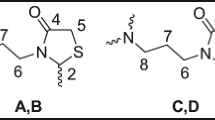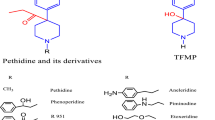Abstract
The present study describes an approach to synthesize the smaller chain tripeptides and tetrapeptides and to test their antinociceptive potency in mice. Based on rational drug design using hydrophobic ratio and total net charge as descriptors, five leads were selected, viz., Met-Arg-Tyr (MRY), Met-Val-Tyr (MVY), Met-Ile-Cys-Tyr (MICY), Met-Trp-Lys-Tyr (MWKY) and Phe-Trp-Lys-Tyr (FWKY) from the subjected 65 templates and synthesized by dicyclohexyl carbodiimide coupling using polystyrene as solid support. All the synthesized compounds were purified by column chromatography and further confirmed by melting point, infrared, proton nuclear magnetic resonance and mass spectral datas. Acute toxicity studies were performed for dose selection in all the compounds using OECD guidelines 423 (Annexure 2b). Antinociceptive potency of peptides was tested in Swiss albino mice using acetic acid writhing and hot plate method. The LD50 cut-off mg/kg body weight for tripeptides (MRY, MVY) and tetrapeptides (Met-Ile-Cys-Tyr, Met-Trp-Lys-Tyr, Phe-Trp-Lys-Tyr) were found to be 500–2000 mg/kg and 200–300 mg/kg respectively. The tripeptide MVY have shown maximum antinociceptive action with an average number of writhing as 13 at 150 mg/kg body weight by writhing method, whereas the tripeptide Met-Arg-Tyr have shown maximum potency with the average reaction time of 5.75 min after 15 min at a dose of 150 mg/kg by hot plate method, which clearly indicated that the tripeptides are comparatively potent antinociceptive agents than the tetrapeptides for central neuropathic pain.







Similar content being viewed by others
References
Argoff CE (2013) Topical analgesics in the management of acute and chronic pain. Mayo Clin Proc 88(2):195–205
Barua CC, Talukdar A, Begum SA, Lahon LC, Sarna DK, Pathak DC et al. (2010) Antinociceptive activity of methanolic extract of leaves of Achyranthus aspera Linn. (Amaranthaceae) in animal models of nociception. Indian J Exp Biol 48:817–821
Bhargave CS (2013) Study of effect of nimesulide co-administered with calcium channel blockers on nociception, in Swiss albino mice. Int J Pharmacol Bio Sci 7(1):55–60
Boman H (2003) Antibacterial peptides: basic facts and emerging concepts. J Intern Med 254:197–215
Bruehl S, Apkarian AV, Ballantyne JC, Berger A, Borsook D, Chen WG et al. (2013) Personalized medicine and opioid analgesic prescribing for chronic pain: opportunities and challenges. J Pain 14(2):103–113
Cases RP, Aracil A, Merino JM, Gallar J, Paya EP, Belmonte C et al. (2000) Arginine rich peptides are blockers of VR-1 channels with analgesic activity. FEBS Letts 481(2):131–136
Committee on Advancing pain research, and Education; Institute of Medicine (2011) Relieving pain in America: a blueprint for transforming prevention, care, education, and research. National Academic Press, Washington
Gao B, Li H, Xia D, Sun S, Ba X (2011) Amphiphilic dendritic peptides: synthesis and behavior as an organogelator and liquid crystal. Beilstein J Org Chem 7:198–203
Garabedian BS, Dardenne M, Pleau JM, Saade NE (2002) Potent analgesic and anti-inflammatory actions of a novel thymulin related peptide in the rat. Br J Pharmacol 136(6):947–955
Gross JH (2010) Mass spectrometry-a textbook. Springer International, Heidelberg, 300–307
Kiso Y, Kitagawa K, Nobuyuki K, Akita T, Takagi H, Amano H et al. (2010) Neo-kyotorphin (Thr-Ser-Lys-Tyr-Arg), a new analgesic peptide. FEBS Letts 155(2):281–284
Koeter HBMW (1990) The science and the art of regulatory toxicology: how to deal with alternative tests. OECD Environment Monographs, USA
Mogil JS (2009) Animal models of pain: progress and challenges. Nat Rev Neurosci 10:283–294
Ogawa T, Miyamae T, Murayama K, Okuyama K, Okayama T, Hagiwara M et al. (2002) Synthesis and structure activity relationships of an orally available and long acting analgesic peptide, Nα-Amidino-Tyr-D-Arg-Phe-Me β Ala-OH (ADAMB). J Med Chem 45(23):5081–5089
Pawar SD, Gaidhani SN, Anandan T, Lavekar GS, Kumari S, Padhi MM et al. (2011) Evaluation of anti-inflammatory, analgesic and anti-arthritic activity of yograja guggulu in laboratory animals. Int J Pharmacol Bio Sci 5(2):17–25
Poole S, Bristow AF, Lorenzetti BB, Gaines Das RE, Smith TW, Ferreira SH (1992) Peripheral analgesic activities of peptides related to α-melanocyte stimulating hormone and interleukin-1β. Br J Pharmacol 106(2):489–492
Silbert BS, Lipkowski AW, Cepeda MS, Szyfelbein SK, Osgood PF, Carr DB (1991) Analgesic activity of a novel bivalent opioid peptide compared to morphine via different routes of administration. Agents Actions 33(3-4):382–387
Silverstein RM, Webster FX (2005) Spectrometric identification of organic compounds. Wiley India (P) Ltd., New Delhi
Stahl E (1969) Thin layer chromatography. Springer International, Berlin
Tegge W, Bonafe CFS, Teichmann A, Erck C (2010) Synthesis of peptides from α- and β-tubulin containing glutamic acid side chain linked oligo-glu with defined length. Int J Peptides. doi: 10.1155/2010/189396
Terasaki T, Deguchi Y, Sato H, Hirai K, Tsuji A (1991) Invivo transport of a dynorphin-like analgesic peptide, E-2078, through the blood brain barrier: an application of brain microdialysis. Pharmaceutical Res 8(7):815–820
Waltraud B, Halina M, Shaaban M, Thomas S, Pierre RJM, Jean-Louis J et al. (2001) Analgesic and anti-inflammatory effects of two novel (kappa)-opioid peptides. Anesthesiology 94(6):1034–1044
Wilcox NL (1994) Regulatory aspects in the US Food and drug administration: in alternative methods in toxicology. Mary Ann-Liebert Inc., USA
Acknowledgments
The authors remain thankful to Dr. Umakant Bajaj, Principal, KIET School of Pharmacy for the provision of laboratory facilities.
Author information
Authors and Affiliations
Corresponding author
Ethics declarations
Conflict of interest
The authors declare that they have no competing interests.
Rights and permissions
About this article
Cite this article
Nagarajan, K., Kumar, V., Grover, P. et al. Anti-nociceptive effect of some synthesized smaller chain tripeptides and tetrapeptides in mice. Med Chem Res 25, 2752–2772 (2016). https://doi.org/10.1007/s00044-016-1695-7
Received:
Accepted:
Published:
Issue Date:
DOI: https://doi.org/10.1007/s00044-016-1695-7




